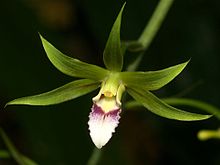| Eulophia | |
|---|---|

| |
| Eulophia euglossa | |
| Scientific classification | |
| Kingdom: | Plantae |
| Clade: | Tracheophytes |
| Clade: | Angiosperms |
| Clade: | Monocots |
| Order: | Asparagales |
| Family: | Orchidaceae |
| Subfamily: | Epidendroideae |
| Tribe: | Cymbidieae |
| Subtribe: | Eulophiinae |
| Genus: | Eulophia R. Br. nom. cons.[1] |
| Species | |
| Synonyms[2] | |
|
List
| |
Eulophia, commonly known as corduroy orchids,[3] is a genus of about two hundred species of flowering plants in the orchid family, Orchidaceae. Most Eulophia orchids are terrestrial but some are deciduous while others are evergreen. They either have an underground rhizome or pseudobulbs on the surface and those species with leaves have them on the end of a fleshy stem. The flowers are arranged on a thin flowering spike, the flowers having sepals which are larger than the petals. The genus is widely distributed but most species are found in Africa and Asia, usually growing in shady places with grass or shrubs in forests.
- ^ "Eulophia". World Checklist of Selected Plant Families (WCSP). Royal Botanic Gardens, Kew.
- ^ Eulophia R.Br. Plants of the World Online. Retrieved 6 July 2024
- ^ Jones, David L. (2006). A complete guide to native orchids of Australia including the island territories. Frenchs Forest, N.S.W.: New Holland. p. 358. ISBN 1877069124.